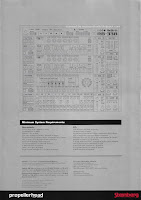Propellerhead ReBirth (RB-338) Techno Micro Composer Version 2.0 "Believe the unbelievable" four page colour brochure from 1998.
No. This isn't a repeat. Although at first glance it very well looks like it. That lovely shiny silver front and back cover, the wire-frame imagery that gets peppered around the inside pages and the line diagram of the software interface on the back. Its fun to see how the writers decided to keep a lot of text in the brochure.
But as you can see, by the time Version 2.0 rolled around, there was a lot of new features and functionality to talk about.
First - the software itself. They had delightfully added a TR-909 drum machine, a compressor and a cool little synchronized filter (that was actually introduced in version 1.5!). That's in addition to the two TB-303s, a TR-808, a digital delay and a distortion that was initially released in Version 1.
But more exciting to me as a two-bit historian and archivist though, is how the company updated the wording in the brochure to reflect its closer association with Roland's instruments.
For example, in the first version of the brochure, Steinberg/Propellerhead were very low-key in their association. They let the images in the brochure speak for themselves and instead of directly referring to the TB-303 and TR-909 would use Roland-speak words like "bassline" and "303 sound".
But by Version 2.0, Propellerhead decided to makes its association with Roland a little more concrete by directly referring to the TB-303, TR-808 and TR-909 in its opening paragraph in the brochure. What changed? Well, according to the the Rebirth Museum Web site (which no longer exists but can be accessed through the Wayback Machine thank you very much), quite a few downloads of the alpha version of ReBirth came from Roland HQ in Japan, who then reached out and eventually stipulated that the following be added to the packaging and splash screen.
"ReBirth was inspired by the TR-808 and TB-303, originally created by Roland Corporation. Their unique sounds and visual images have been re-born through digital simulation by Propellerhead Software."And while something similar exists in the V1 brochure, its not exactly the same.
But by V2, Propellerhead had included this exact phrase (with the inclusion of the TR-909) in the second iteration of the brochure. And then some:
Could it be that the V1 brochure was printed prior to the agreement between Roland and Propellerhead? Cool thought.
Either way, as mentioned on the now defunct Rebirth Museum Web site, Propellerhead considered this a "thumbs-up" by Roland and a good reason for Propellerhead to strengthen its association with Roland in V2 of the brochure.
"Propellerhead Software regarded this as a blessing from Roland, as it was considered an "unofficial thumbs-up" and their acknowledgment provided strong marketing leverage. In a sense, Roland's stamp of approval legitimized ReBirth as something that met the standards of Roland quality."This story is now canon in Propellerhead-land, but I wonder if Roland has the same memory of events.
The incorporation of new gear wasn't the only reason ReBirth users were excited for V2.0. As can be seen in the brochure, ReBirth allowed users to create their own front panel graphics and, even more important (and fun!) for me, create custom sounds. Along with an "exchange platform" for songs and mods.
Propellerhead's ReWire functionality was also introduced in V2. Initially code named "TopHat", ReWire was created to connect audio and synchronization between ReBirth and Cubase". And, it eventually became a standard for other companies that wanted to sync their software to Rebirth.
And this leads me into one of the biggest, yet subtle changes to the V2 brochure. Along with ReWire came the ability for a lot of musicians to sync up ReBirth with other professional software. So, it made sense for Propellerhead to boost the "professional appeal" of ReBirth in the "Functions Overview" section.
Take a closer look and you will see that in V1, the first bullet point in this section highlights Roland's machines. And rightly so, since its ALWAYS ALL ABOUT THE ROLAND GEAR!!!!!
"Two bass line synthesizers, one "analog" drum machine, a distortion box and a delay."But in V2, those instruments have been bumped to bullet point #3. And what has made it to the number one feature in the overview?
"16 bit, 44.1 kHz audio quality (stereo)."Yup. The instruments took a back seat to audio quality. Okay, not really - just in the bullet points.
But it still makes me nervous, and I sometimes wonder if that was some kind of foreshadowing.
Anyways, that's enough thinking for today. Time to play with ReBirth 2.0 on my Windows 10 laptop.







2 comments:
Is there a way to contact you? I have the french ad for reason 2.5, I can send you the scans.
We need higher quality scans of this legend.
Post a Comment